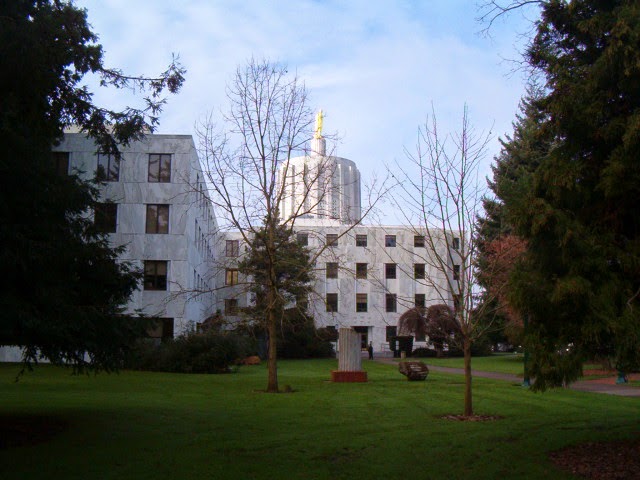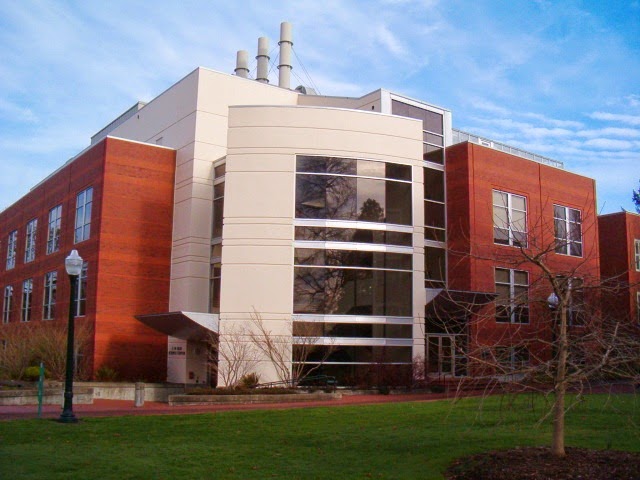This walk begins at the Mt. Tabor Presbyterian Church, located at the intersection of SE Belmont Street and SE 55th Avenue. While the church has been located at this site since 1892, this building was constructed in 1910. The ever-popular (at the time) bell tower designed to look like a romanticized medieval castle turret dominates the structure. The church has made great efforts in recent years to reach out to the community in different ways, efforts that are chronicled on the church's website.
Cross Belmont Street to the east side of SE 55th Avenue. At the corner is the Irvington Masonic Lodge building, which according to a plaque in the front was constructed in 1952 - it looks much older. There is no sign of continued masonic use of the building, which is not surprising given the steep decline in Masonic membership in the U.S. over the past several decades. Although no signs indicate it, the building now houses the Mt. Hood Model Engineers Club, dedicated to the creation and maintenance of model trains.
From the Masonic Lodge building continue south on 55th Avenue. This street contains a number of fine old homes. This one on the right between Taylor and Salmon Streets, built in 1900, is located on a lot almost one acre in size, and now houses the Vedanta Society of Portland. Vedanta philosophy claims to be the foundation of Hinduism. The leaders of the society are known as Swamis. The current leader in Portland is Swami Shantarupananda.
Continuing along SE 55th Avenue, on the left between Salmon and Madison is the Samuel Cobb House, a large craftsman-style home constructed in 1911. It is on the National Register of Historic Places. Samuel Cobb was a prosperous Portland sawmill owner who designed and built the house himself. Among the beautiful craftsman interior finishes are seven fireplaces.
The next block on the left, between Madison and Hawthorne, is home to the Western Theological Seminary Portland branch. The seminary describes itself as "a theologically conservative graduate school that promotes true innovation and humility in ministry practice. The Bible is God's inerrant Word and we set it at the center of our curriculum in the belief that faith and practice must be driven by principled interpretation and integration of the scriptures." However the house itself is located on the site of the first home in the area, constructed by pioneer Peter Prettyman in 1846, at the head of Hawthorne Street. The current house was constructed by Philip Buehner in the first decade of the 20th century. A history of the site and the house can be found here.
At Hawthorne Street, after passing the Seminary building, turn left. Go five blocks through the neighborhood to 60th Avenue, where you should carefully cross this busy street. turn right, and after a few hundred feet you will see this stairway on the left. Take it up to the turret above, which you will soon see is part of the Mt. Tabor water reservoir.
At the top of the steps you will see the main reservoir. Before turning right to go around the reservoir, note this sign. Perhaps what this guy did doesn't qualify as "throwing things," but the whole incident created quite a stir! The reservoirs themselves must be decommissioned from holding city drinking water, but the fate of the reservoirs after they are drained of drinking water is still being decided by the city. And some in the area are still fighting any kind of reservoir closure.
At the corner of the reservoir turn left and continue around it. At the next corner, veer to the right away from the reservoir and start heading up a roadway, which is really a paved trail. Keep going up the hill on the gradual slope, and stay off the more developed roadway you will see below you. Mt. Tabor, for those who are interested, is an extinct volcano cinder cone. It is 636 feet in elevation - however, this hike doesn't take you to its top.
Eventually you will see ahead in the distance the maintenance building for the Mt. Tabor upper reservoir. A trail will veer to the right - take it and start heading down the hill. Eventually you will see this plank wooden stairway heading down the hill to the right. Take the stairs. At the bottom of the first set of stairs is the Mt. Tabor off-leash dog park. If you were to continue down the stairs, you would reach the campus of Warner Pacific College.
However at the end of the first set of stairs turn right and travel through the off-leash dog park. Eventually you will get to this gate. Go through the gate and turn left on the roadway, and then quickly right onto SE Lincoln Street. Ahead is a long strip of park land with a street and homes on each side. On one side (to the right) are older Mt. Tabor neighborhood homes, on the other (to the left) are homes that were built in the late 1980's.
On this park block you will soon pass by this community garden. There are 50 of these community gardens located on Portland City park land throughout the city.
Continue to the west end of the park strip and then cross 60th Avenue at Lincoln Street. Continue west on Lincoln Street. At the corner of 54th and Lincoln, on the left is the Lincoln Street Kayak and Canoe Museum. The Museum is open on Wednesday from 5 to 7 PM, and admission is free. It looks like a great place to visit if you are interested in kayaks and canoes.
Turn right onto 54th Avenue. The next long block has a good variety of housing types from the early 20th century. This purple house on the left exemplifies the two-story "bungalow" style, with a dormered second story and a generous front porch. Next to this house on the left is a 1982 addition to the neighborhood, very much out of character architecturally.
 When you get to Hawthorne Blvd. take a left, but first glance to the right and you will see a block away the imposing Western Seminary mansion that you passed earlier along the route. Quickly turn right onto SW 53rd Avenue. At 53rd and Salmon, to the right, is this impressive 1911 home.
When you get to Hawthorne Blvd. take a left, but first glance to the right and you will see a block away the imposing Western Seminary mansion that you passed earlier along the route. Quickly turn right onto SW 53rd Avenue. At 53rd and Salmon, to the right, is this impressive 1911 home. Continue on 53rd Avenue. On the left, one house before the intersection of 53rd and Taylor, is this home built in a traditional early-20th-Century style. But it has that "new" look. Another tell-tale sign: if you look closely the house appears to have no basement windows, and therefore no basement. In fact, this house was constructed in 2010. It is much more respectful of neighborhood architectural traditions than the houses plopped into neighborhoods like this from the 1960's through the 1980's.
Continue on 53rd Avenue. On the left, one house before the intersection of 53rd and Taylor, is this home built in a traditional early-20th-Century style. But it has that "new" look. Another tell-tale sign: if you look closely the house appears to have no basement windows, and therefore no basement. In fact, this house was constructed in 2010. It is much more respectful of neighborhood architectural traditions than the houses plopped into neighborhoods like this from the 1960's through the 1980's.At Taylor turn left, and then turn quickly to the right to get back on the next leg of 53rd Avenue. Continue one block to Belmont Street. On the left is this structure on the National Register of Historic Places, the Blaine Smith house. It sits on a lot of almost 1/2 acre. The Arts and Crafts-style home was built in 1909.

Cross Belmont Street and continue north to Morrison Street, where you will turn right. On the right at the corner of 54th and Morrison is the Brainard House. This Victorian-style home has been here since 1888. It is also on the National Register of Historic Places.
On the left, diagonally across the intersection from the Brainard House, is another grand Victorian-era home. This one was built in 1890, but is not on the National Register.
Continue one more block to 55th Avenue, then turn right, and you will be back at your starting point for this walk.








































